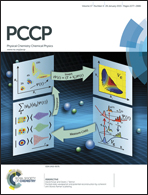Pentaglyme–K salt binary mixtures: phase behavior, solvate structures, and physicochemical properties†
Abstract
We prepared a series of binary mixtures composed of certain K salts (KX) and pentaglyme (G5) with different salt concentrations and anionic species ([X]−: [(CF3SO2)2N]− = [TFSA]−, [CF3SO3]− = [TfO]−, [C4F9SO3]− = [NfO]−, PF6−, SCN−), and characterized them with respect to their phase diagrams, solvate structures, and physicochemical properties. Their phase diagrams and thermal stability strongly implied the formation of equimolar complexes. Single-crystal X-ray crystallography was performed on certain equimolar complexes, which revealed that G5 molecules coordinate to K+ cations in a characteristic manner, like 18-crown-6 ether in the crystalline state, irrespective of the paired anions. The solvate structures in the molten state were elucidated by a combination of temperature-dependent Raman spectroscopy and X-ray crystallography. A drastic spectral variation was observed in the [K(G5)1][TfO] Raman spectra, indicating that solvate structures in the crystalline state break apart upon melting. The solvate stability of [K(G5)1]X is closely related to the ion–ion interaction of the parent salts. A stable solvate forms when the ion–dipole interaction between K+ and G5 overwhelms the ion–ion interaction between K+ and X−. Furthermore, the physicochemical properties of certain equimolar mixtures were evaluated. A Walden plot clearly reflects the ionic nature of the molten equimolar complexes. Judging from the structural characteristics and dissociativity, we classified [K(G5)1]X into two groups, good and poor solvate ionic liquids.


 Please wait while we load your content...
Please wait while we load your content...